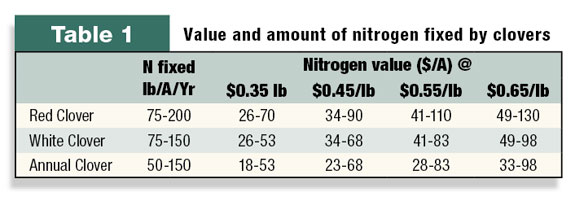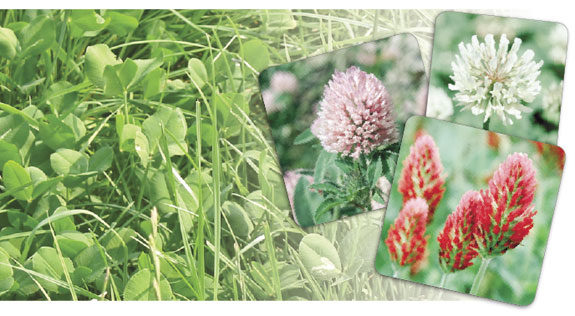If natural gas consumption continues to increase relative to production and if imports increase as predicted (from 15 percent in 2003 to 28 percent in 2025), it is virtually certain that there will be long-term increases in the cost of nitrogen (N) fertilizer.
This is a serious development for forage/livestock producers because N fertilizer usually accounts for 20 to 40 percent of the cost of producing grass forage. The extent to which a producer is able to minimize this expense may mean the difference between profit and
no profit.
The single-most beneficial technique for lowering N fertilizer cost on most livestock farms in humid regions of the U.S. is to grow forage legumes, and in many situations, the best legume option is clover. One or more species of clover are well suited to a high percentage of forage production sites and situations.
Clovers are compatible with many grasses and are relatively inexpensive to establish. They also provide excellent quality forage and thus improve animal performance. In many situations, they can help extend the grazing season and may also increase forage yield as compared to grasses alone.
Nitrogen fixation process
In association with Rhizobium bacteria, clovers and other legumes obtain N from the atmosphere. The bacteria infect the roots of legume plants, from which they obtain food. The bacteria obtain N from air in the soil and “fix” it in a form usable by plants. The N accumulates in small nodules (knots) that form on the legume roots.
The amount of N fixed varies due to several factors. These include legume species, temperature, strains of bacteria present, extent of sunlight versus shading, soil pH, soil nutrient availability and extent of defoliation. Applying materials to the land that provide 25 pounds or more of chemical N fertilizer per acre tend to decrease the amount of N fixed biologically.
Clover seed inoculation
While some Rhizobium bacteria may already be present in a field in which clover is to be planted, seed inoculation (putting bacteria on the seed) helps ensure there will be adequate populations of the right type of bacteria present to obtain good N fixation.
Most seed of white clover and red clover, and some seed of other clovers, are pre-inoculated. This helps ensure ample bacteria populations in the vicinity of clover roots. Clover seed that has not been pre-inoculated should be inoculated with fresh inoculants just prior to being planted.

Economic importance
Ranges for the amount and value of N fixation per acre by red clover, white clover, and annual clovers (in an adequate stand) are provided in Table 1.
The cost of planting clover also varies in different situations and with various clovers, but it is usually much less than the value of the N the clover fixes.
Thus, any other benefits from growing clovers such as improved animal performance, better growth distribution or increased total forage yield, are a bonus. Clovers are also an excellent source of protein, and in many situations can be of great economic value by reducing or eliminating the need to purchase protein supplement.
Other benefits
As compared to applying commercial N fertilizer, biological N-fixation by clovers offers several additional benefits. Commercial nitrogen fertilizers acidify the soil, thus hastening the need to apply lime to raise soil pH. Legume N is a slow-release source of this important element, which is less acidifying and more environmentally friendly. Clovers also furnish pollen and nectar for bees, tend to favor beneficial insects and are a preferred food of many species of wildlife.
There are only a few options for furnishing N for plant growth. Given the expense of commercial N fertilizer and limitations associated with other alternatives, use of legumes to provide significant quantities of inexpensive N and to enhance performance of grazing animals is increasingly attractive. Clover is the most logical type of legume to use in many forage situations.
In simple terms, profit ewquals expenses minus income. Thus, profit can be increased either by increasing income or by reducing expenses. By boosting forage quality while reducing nitrogen fertilizer expense, clovers can do both. FG
For more information, visit the Oregon Clover Commission website at www.oregonclover.org

- Don Ball
- Extension Agronomist
- Auburn University










